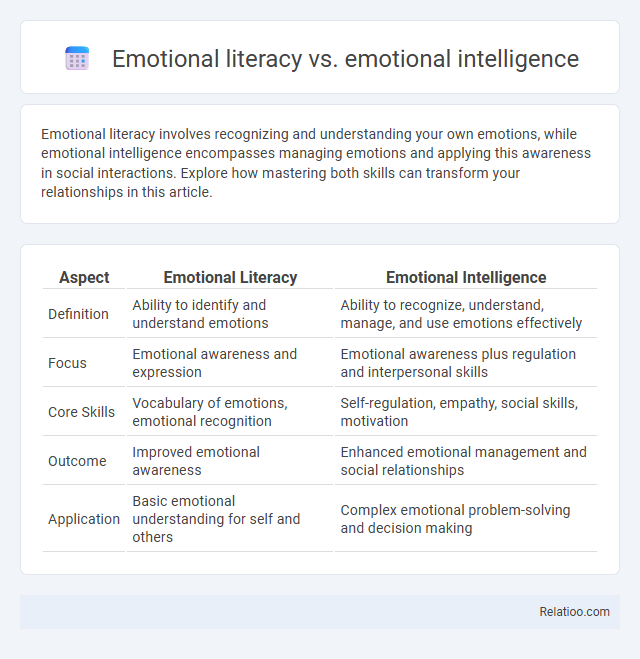Emotional literacy involves recognizing and understanding your own emotions, while emotional intelligence encompasses managing emotions and applying this awareness in social interactions. Explore how mastering both skills can transform your relationships in this article.
Table of Comparison
| Aspect | Emotional Literacy | Emotional Intelligence |
|---|---|---|
| Definition | Ability to identify and understand emotions | Ability to recognize, understand, manage, and use emotions effectively |
| Focus | Emotional awareness and expression | Emotional awareness plus regulation and interpersonal skills |
| Core Skills | Vocabulary of emotions, emotional recognition | Self-regulation, empathy, social skills, motivation |
| Outcome | Improved emotional awareness | Enhanced emotional management and social relationships |
| Application | Basic emotional understanding for self and others | Complex emotional problem-solving and decision making |
Defining Emotional Literacy
Emotional literacy involves recognizing, understanding, and expressing your own emotions effectively, forming the foundation for emotional intelligence and emotional competence. Emotional intelligence expands on this by incorporating skills like empathy, emotional regulation, and social interaction, enabling you to navigate complex emotional landscapes. Emotional competence encompasses both, highlighting the practical application of emotional knowledge to achieve personal and interpersonal success.
What is Emotional Intelligence?
Emotional intelligence is the ability to recognize, understand, and manage your own emotions while effectively navigating and influencing the emotions of others. It encompasses skills such as emotional awareness, empathy, self-regulation, and social skills, which contribute to better communication and relationship management. Unlike emotional literacy, which primarily involves identifying and expressing emotions, emotional intelligence includes applying this understanding to make thoughtful decisions and respond adaptively in social contexts.
Key Differences Between Emotional Literacy and Emotional Intelligence
Emotional literacy refers to the ability to recognize, understand, and express emotions appropriately, while emotional intelligence encompasses a broader set of skills, including managing emotions, empathy, and social interaction. The key differences between emotional literacy and emotional intelligence lie in application; emotional literacy is foundational, focusing on identification and expression, whereas emotional intelligence involves using that understanding to navigate relationships and solve emotional challenges effectively. Your development in emotional literacy builds the essential groundwork that enhances overall emotional intelligence for better personal and professional interactions.
Components of Emotional Literacy
Emotional literacy involves recognizing, understanding, and expressing emotions effectively, focusing on self-awareness and empathetic communication. Unlike emotional intelligence, which includes managing emotions and using them to guide thinking and behavior, emotional literacy primarily emphasizes the foundational skills of identifying and articulating feelings. Your ability to develop emotional vocabulary, interpret emotional cues, and practice emotional regulation forms the core components of emotional literacy.
Core Elements of Emotional Intelligence
Emotional intelligence encompasses core elements such as self-awareness, self-regulation, motivation, empathy, and social skills, enabling individuals to manage their emotions and relationships effectively. Emotional literacy refers specifically to the ability to recognize, understand, and express emotions accurately, serving as a foundational aspect of emotional intelligence. While emotional competency is a broader term that includes emotional intelligence and literacy, core elements focus on developing interpersonal skills and emotional management to enhance personal and professional success.
The Role of Self-Awareness in Emotional Skills
Emotional literacy, emotional intelligence, and emotional regulation are interconnected skills essential for effective emotional functioning, with self-awareness serving as the foundation across all three. Self-awareness enables individuals to accurately recognize and label their own emotions, facilitating better emotional literacy by improving understanding and communication of feelings. This heightened self-awareness also enhances emotional intelligence by allowing for more adaptive responses and improves emotional regulation by providing the insight necessary to manage and modulate emotional reactions effectively.
Applications in Daily Life: Literacy vs Intelligence
Emotional literacy involves recognizing and understanding your own emotions and those of others, enabling effective communication and empathy in daily interactions. Emotional intelligence extends this by incorporating skills like emotional regulation, problem-solving, and social awareness, which are crucial for managing stress and building relationships at work or home. Applying emotional literacy helps you interpret feelings accurately, while emotional intelligence allows you to use those insights strategically to improve decision-making and conflict resolution.
Emotional Skills in Education and Workplaces
Emotional literacy, emotional intelligence, and emotional skills each play crucial roles in education and workplaces, with emotional literacy focusing on recognizing and understanding emotions, emotional intelligence encompassing the ability to manage and use emotions effectively, and emotional skills involving practical application in communication and relationships. Your ability to develop emotional skills enhances collaboration, conflict resolution, and leadership quality, fostering a supportive learning and work environment. Emphasizing emotional literacy in curricula and professional training equips individuals with the foundational tools for emotional intelligence growth and workplace success.
Developing Emotional Literacy and Intelligence
Developing emotional literacy involves recognizing, understanding, and expressing your emotions clearly, which forms the foundation for emotional intelligence that expands into managing emotions and empathizing with others effectively. Emotional literacy allows you to identify your feelings, while emotional intelligence uses that awareness to regulate emotions and navigate social interactions skillfully. Enhancing both skills improves personal well-being, communication, and relationship-building.
Why Understanding the Distinction Matters
Understanding the distinction between emotional literacy, emotional intelligence, and emotional agility matters because each concept uniquely enhances your ability to recognize, manage, and respond to emotions effectively. Emotional literacy focuses on your ability to identify and label emotions accurately, while emotional intelligence encompasses broader skills like empathy, social skills, and emotional regulation. Emotional agility emphasizes the capacity to navigate emotional experiences with flexibility, making it crucial for personal growth and effective communication.

Infographic: Emotional literacy vs Emotional intelligence
 relatioo.com
relatioo.com